
Forage is a plant material eaten by grazing livestock. Historically, the term forage has meant only plants eaten by the animals directly as pasture, crop residue, or immature cereal crops, but it is also used more loosely to include similar plants cut for fodder and carried to the animals, especially as hay or silage. The term forage fish refers to small schooling fish that are preyed on by larger aquatic animals.
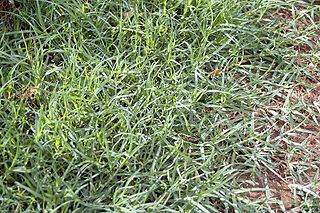
Cynodon dactylon, known as Bermuda grass, Dhoob, dūrvā grass, ethana grass, dubo, dog's tooth grass, Bahama grass, devil's grass, couch grass, Indian doab, arugampul, grama, wiregrass and scutch grass, is a grass found worldwide. It is native to Europe, Africa, Australia and much of Asia. It has been introduced to the Americas. Although it is not native to Bermuda, it is an abundant invasive species there. In Bermuda it has been known as "crab grass".

Lotus corniculatus is a flowering plant in the pea family Fabaceae, native to grasslands in temperate Eurasia and North Africa. Common names include common bird's-foot trefoil, eggs and bacon, birdsfoot deervetch, and just bird's-foot trefoil, though the latter name is often also applied to other members of the genus.

Cynodon is a genus of plants in the grass family. It is native to warm temperate to tropical regions of the Old World, as well as being cultivated and naturalized in the New World and on many oceanic islands.
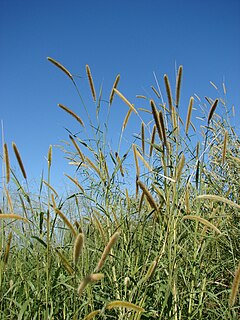
Cenchrus purpureus, synonym Pennisetum purpureum, also known as Napier grass, elephant grass or Uganda grass, is a species of perennial tropical grass native to the African grasslands. It has low water and nutrient requirements, and therefore can make use of otherwise uncultivated lands. Historically, this wild species has been used primarily for grazing, recently, however, it has been used as part of a push–pull agricultural pest management strategy. Napier grasses improve soil fertility, and protect arid land from soil erosion. It is also utilized for firebreaks, windbreaks, in paper pulp production and most recently to produce bio-oil, biogas and charcoal.
Acroceras macrum is a species of perennial grass native to Africa, which is often cultivated extensively as pasture, silage, and hay. It is palatable and nutritious for animal feed. The roots are extended rhizomes and it produces spiked inflorescences 2–8 cm long. The bright green, lanceolate leaves are typically 8–20 cm long, with the whole plant being about 20–70 cm tall. It has been studied in breeding programs and it has been introduced to Australia and South America for cultivation.
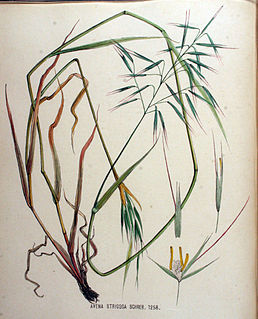
Avena strigosa is a species of grass native to Europe, and its seeds are edible. This plant is often cultivated as animal feed in the south Brazil, and it is sometimes reported as a weed.

Chloris gayana is a species of grass known by the common name Rhodes grass. It is native to Africa but it can be found throughout the tropical and subtropical world as a naturalized species.

Urochloa brizantha is a species of grass known by the common name palisade grass. It is often used as a forage for livestock.

Digitaria didactyla is a species of grass known by the common names blue couch, Queensland blue couch, blue serangoon grass, green serangoon grass, blue stargrass, and petit gazon. It is native to Mauritius, Réunion, parts of mainland Africa, and Madagascar. It has been introduced widely outside its native range, mainly for use as a pasture and turf grass. It has naturalized in some regions.

Hyparrhenia rufa is a species of grass known by the common names jaraguá, jaraguá grass, and giant thatching grass. It is native to Africa and it is widespread in the world as a cultivated forage and fodder for livestock and a naturalized and sometimes invasive species.
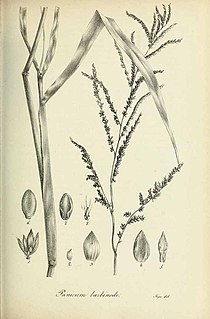
Brachiaria mutica is a species of grass known by the common names para grass, buffalo grass, Mauritius signal grass, pasto pare, malojilla, gramalote, parana, Carib grass, and Scotch grass. Despite its common name California grass, it does not occur in California; it is native to northern and central Africa and parts of the Middle East, where it is cultivated for fodder. It was introduced elsewhere and it is now cultivated throughout tropical regions of the world for this purpose.

Indigofera hirsuta, the hairy indigo or rough hairy indigo, is a species of flowering plant in the family Fabaceae. It is native to nearly all the world's tropics; South America, Africa, Madagascar, the Indian Subcontinent, southern China, southeast Asia, Malesia, Papuasia and Australia, and has been introduced to the Caribbean, the southeast United States, Mexico and Central America. It is used as a green manure and, to a minor extent, for forage.

Vicia narbonensis, called Narbon bean, Narbon vetch, Narbonne vetch and moor's pea, is a widely distributed species of flowering plant in the family Fabaceae. It is native to Madeira and the Mediterranean countries through to Central Asia and the western Himalayas, and has been introduced to central and eastern Europe, and scattered other locations. It has some palatability issues, but has potential as a green manure and forage crop, and for its beans. It is the namesake of the Vicia narbonensis species complex.
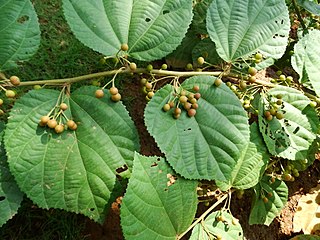
Grewia optiva, the bhimal, is a species of flowering plant in the family Malvaceae, native to the Indian Subcontinent.

Grewia bicolor, called bastard brandy bush, false brandy bush, two-coloured grewia, white-leaved grewia, white-leaved raisin, white raisin and donkey berry, is a species of flowering plant in the family Malvaceae, native to Sub‑Saharan Africa, Yemen, Oman, and the Indian Subcontinent. In Africa Grewia bicolor is one of the most important forages during the dry season, when all herbivores, wild and domestic, find it palatable. It is particularly enjoyed by giant eland and domestic goats.

Indigofera spicata, the creeping indigo or trailing indigo, is a species of flowering plant in the family Fabaceae. It is native to Sub‑Saharan Africa, Madagascar, Mauritius, Réunion, and Yemen, and has been introduced to the southeastern United States, various Caribbean islands, Brazil and other locations in Latin America, various Pacific islands, and New South Wales and Queensland in Australia. It was considered to be a promising forage plant, and then shown to be toxic to nearly all livestock, but it is possible that the experiments were conducted on the similar Indigofera hendecaphylla, leading to some confusion.
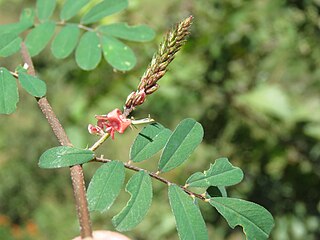
Indigofera hendecaphylla, the creeping indigo or trailing indigo, is a species of flowering plant in the family Fabaceae. It is native to the Old World Tropics and Subtropics, and has been introduced to various locales, including Japan and Australia. It was widely introduced as a forage plant when it was thought to be conspecific with Indigofera spicata, and then shown to be toxic to nearly all livestock, with some uncertainty as to which species was tested.

Stylosanthes guianensis, the stylo, is a species of flowering plant in the family Fabaceae. It is native to the New World Tropics and Subtropics, and has been introduced to Puerto Rico, the Windward Islands, Trinidad and Tobago, most of Sub‑Saharan Africa, Madagascar, Mauritius, Réunion, Rodrigues, the Indian Subcontinent, Sri Lanka, Thailand, southeast China, Hainan, Taiwan, New Guinea, Queensland, New Caledonia, and the Cook Islands. An important forage and fodder species, its palatability to livestock increases as the plant matures, making it an unusual, and valuable, deferred feed. It has high genetic diversity between and among its named varieties.

Stylosanthes hamata, the Caribbean stylo, is a species of flowering plant in the family Fabaceae. It is native to the islands of the Caribbean, and nearby areas on the mainland; Mexico, Guatemala, Costa Rica, Colombia, and Venezuela, and it has been introduced as a forage crop to Florida, Peru, Brazil, the Gambia, Burkina Faso, Benin, India, Thailand, Hainan, and northern Australia. There are diploid and tetraploid cultivars, with the tetraploids being more drought tolerant and more frequently sown for pasture.


















